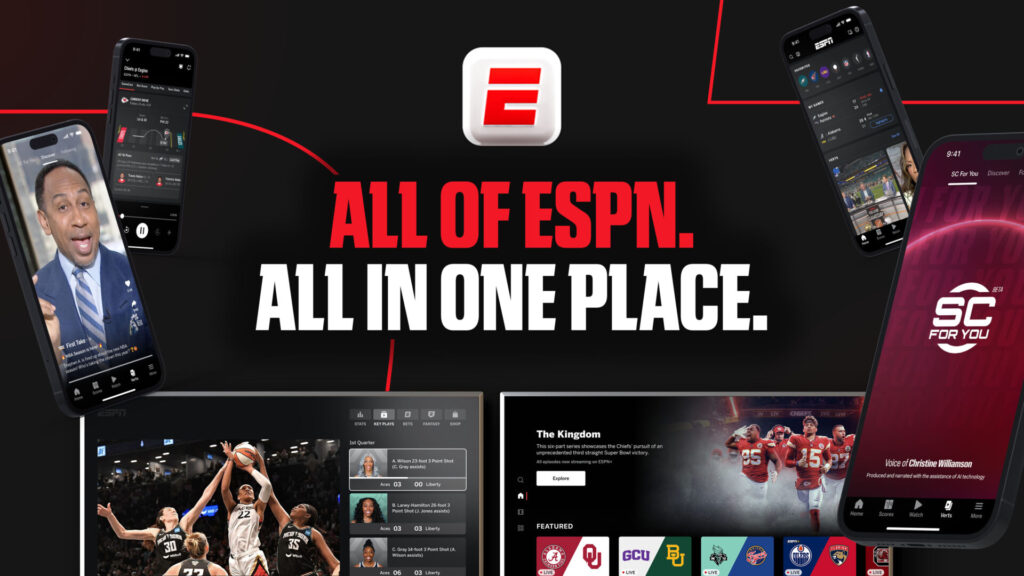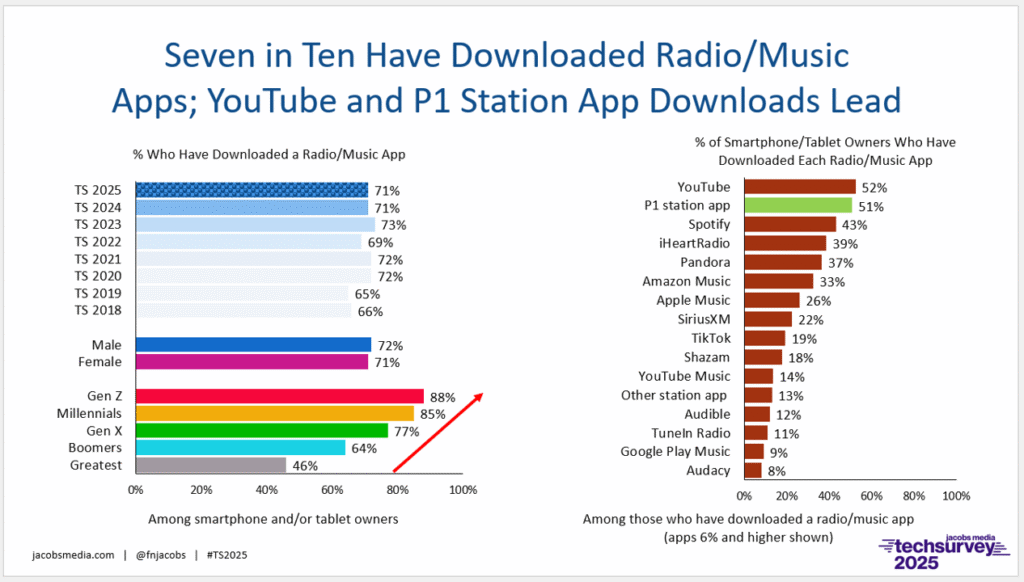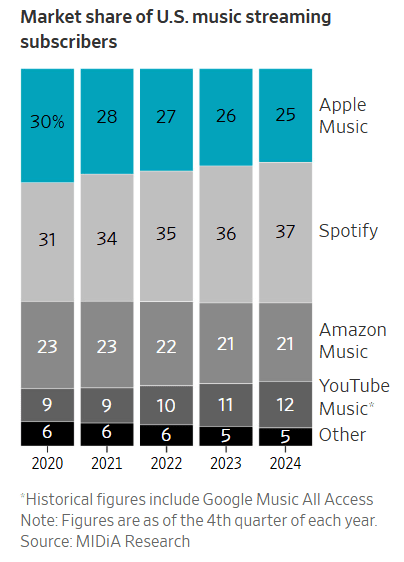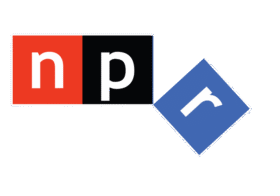
Today, you get us both. Brother Paul and I collaborated on today’s post in the hope we more effectively make our points working together—which is another lesson in the post itself.
As we’ve learned by paying attention at CES over the last many years, some of the best inventions and advancements are born out of collabs, where two specialized companies combine their expertise to make something better. It’s the old 1+1=3 concept, and when it works, it can be a beautiful thing.
For this post, its Paul’s knowledge of mobile apps combined with my love for innovation. And it’s just Monday. Thanks for stopping by and checking it out. – FJ
“Memo To Radio: Apps Are F@#&ing Back!” – By Fred & Paul Jacobs
For the past few years, media and tech pundits have made the claim mobile apps are over, despite increasing downloads and usage across the board, and as importantly, corporate investment. Maybe these “talking heads” were searching for the elusive “next big thing” or maybe they were trying to sell subscriptions. But the fact is, mobile apps have become a premier part of our media culture and aren’t going away any time soon.
We cannot help but see it year after year at CES, as technologists continue to support their inventions with mobile apps to simplify and streamline their operations. Whether you’re buying a home security system, purchasing or leasing a new car, or having a pacemaker put in, chances are it comes with a mobile app. When well-designed, they can help any consumer—no matter their tech savviness or lack thereof—operate pretty much any device from the comfort and familiarity of their preferred mobile device.
 And last month, a major “app” event took place we couldn’t ignore. ESPN, long at the forefront of massive investments in mobile technology has now gone all-in on the platform. This struck us as an interesting move, given that cable subscriptions have always been their bread-and-butter, representing a major share of their revenue stream.
And last month, a major “app” event took place we couldn’t ignore. ESPN, long at the forefront of massive investments in mobile technology has now gone all-in on the platform. This struck us as an interesting move, given that cable subscriptions have always been their bread-and-butter, representing a major share of their revenue stream.
But media habits are, of course, changing…and changing fast. Recognizing the steady decline of cable subscriptions (parallel to the slow but steady decline of broadcast radio listeners), Bob Iger, CEO of Disney and ESPN’s parent, described their strategy in terms any media exec could understand:
“As a company, we’re now agnostic when it comes to linear television and digital television, and digital content—we manage them together and holistically. We look at the whole, and that’s what we’ll do here.”
Let that one sink in, because ESPN has studied its usage patterns on and off cable television. And they’ve assessed the future—in their terms, where the puck is headed. It’s all about their new flagship streaming app—a one-stop experience for all things ESPN.
According to ESPN, “this plan will cover more than 47,000 live events annually, including the NCAA championships, the Australian Open, the PGA Championship and other live events.”
The ESPN app is free for current subscribers of cable, but also Disney+ or Hulu, so this investment in mobile as a great example of meeting the audience where they are.
But if you don’t subscribe to one of these other platforms, ESPN is now offering two different subscription models. There are also “bundle” options with Disney+ and Hulu as well.
As CNBC reports, “it’s the first time the company is offering all of its linear TV content to consumers via streaming.”

via ESPN Newsroom
The fact it’s all available on the most important device we own, the one that instills palpable panic if lost or damaged, speaks volumes about ESPN’s priorities. It also sends a message to other media content providers and factories.
Note that ESPN’s mobile initiative is much more than simply shifting streaming over to mobile. It represents a significant strategy shift that all media outlets—including radio stations—need to take note of.
As many of you know, we launched our own mobile app company—jacapps—17 years ago shortly after Apple’s App Store came online. Since then, we’ve developed more than 1,300 apps for media clients—primarily radio, but more recently, for independent news providers that have sprung up in local markets as traditional media like newspapers are fading.
One thing we continue to observe is the number of stations who buy an app and view it as simply a way of providing the audience an easy way to stream the station on their phones. Many simply “check the box” and the strategy of their investment ends there.
This is why broadcasters should not just study ESPN’s new app, but rather the strategy behind it, because we can learn a lot from their thinking.

Photo: CNN
Paul is a big fan of journalist and media observer Dylan Byers’ podcast, The Grill Room. If you work in media, this is a must-listen. Each week, Dylan provides important perspectives behind the moves and decisions made by media companies across the spectrum. For those of you who don’t know him, Byers is a former Senior Media Reporter for NBC News, and is a founding member and reporter at Puck.
The strategy behind the ESPN app was a recent topic on the Grill Room podcast, as Dylan joined Puck News’ Hollywood streaming expert, Julia Alexander, they dug into what ESPN is thinking.
Early in the podcast, Alexander made the declarative statement, “Apps Are F@#&ing Back!” And she took to task those who wistfully believed online chats and other content were replacing those little “chicklets” that adorn the screens of our iPhones and Androids, providing “beachfront property” access to consumers on their most important device.
Alexander followed up by making an important point: at a time when there is much insecurity around downloading any content, apps provide a safe, walled garden where consumers can be confident about what they’re accessing. When Apple extols web security in their marketing, this is what they’re talking about. (Thank you, Steve Jobs).
At jacapps, we are often asked if apps have seen better days, when in fact, all data to the contrary shows growing interest and use of them. How do we know this?
For one thing, we’ve been tracking app usage in our Techsurveys from the beginning. It’s clear there is steady growth every year, with now more than seven in ten respondents have downloaded a music and/or radio app. Happily, individual mobile apps for radio are especially popular:

From a strategic perspective, having a mobile app is a no-brainer. But the strategy behind ESPN’s move goes much deeper.
Describing the new app as a “nightmare for cable subscribers” who are used to simply turning on their televisions and watching a program, Alexander applauds ESPN for having the guts to go all-in on appealing to non-cable (younger) subscribers who like to simply “mess around” with content. In other words, the app provides more than just streams, but the ability to interact with content in new and novel ways.

Photo: LinkedIn
Alexander describes this as ESPN “placing a bet on acquisition based on new behaviors of a customer base they weren’t reaching (on cable),” and “doing it via a product—not talent—investment.”
While talent matters, that’s not what ESPN’s app is all about. Alexander drives home the point this play is less about personality, and more about investing in a platform to engage new users outside of the traditional boundaries of television, with big rights fees and talent contracts.
And perhaps, that’s the most important point behind ESPN’s strategy. Not only are they abandoning their traditional means of distribution—cable—but they are creating something entirely new that’s still aligned with their brand. Yet, a major strategic initiative is needed to appeal to new users and fans in an entirely different way.
Alexander sums up her opinion about how old-line media companies need to think about the future:
“Legacy media companies need to become faster at experimenting.”
This one podcast goes a long way of defining how radio’s mobile strategy needs to evolve. At a time when broadcast listening and traditional revenue channels are in decline, simply having a mobile app that streams is not going to grow audience or revenue in any significant way.
The ground has shifted—demographically and financially. Radio was among the first media to embrace mobile apps, but they have not changed much since we first start developing them back in 2008.
Case in point: what is your station’s (or company’s) budget for mobile app development? How many mobile app questions are typically included in your station’s perceptual studies (assuming you’re still doing them)?
When your brands have the ability to have a strong presence at the most coveted devices consumers own (yes, more than AM/FM radios), the potential for growth is there. But not if mobile isn’t an integral and active part of your strategy.
At this time of incredible upheaval and media chaos, whether it’s mobile, newsletters, or short-form video, now is the time for stations to truly become faster at experimenting.
It’s one of the reasons why we’re seeing more and more organizations and companies throw at least some corporate caution to the wind and take a shot at things new and different.
The Audacy/iHeart deal that allows the former’s radio stations to stream on the latter’s mobile app platform is a case in point. Five years ago, this “strange bedfellows” collaboration wouldn’t have happened. Today, it is more typical of mashups between two companies you wouldn’t expect to be working together.
While most radio companies may be paying scant attention to their mobile app strategy, iHeart continues to forge ahead:
Another of these was announced just a few days ago, and notably, it involves the brand that popularized mobile phones, while inventing the app store concept:
Apple
Last week, Apple announced its streaming radio stations would now be discoverable on TuneIn, something unthinkable in the past. But given slippage in Apple Music’s share, this attempt to creatively grow audience using a competitor’s platform is par for the course.

via WSJ
As powerful as Apple is, they are what Evan Shapiro refers to as the “Trillion Dollar Death Stars,” and they benefit from innovation, experimentation, and risk-taking. And that means not being afraid to forge smart partnerships—in this case, with Tune-In. With Spotify continuing to grow its share, Apple must stop the bleeding—an ugly 5-year trend showing no sign of abating.
But in order to be proactive, it meant Apple had to put a few stacks of chips in the middle of the table, and take a chance on what many might see as a lessor partner in Tune-In. But not if it can grow Apple sampling—and ultimately subscriptions, the Holy Grail of music streaming.
in Tune-In. But not if it can grow Apple sampling—and ultimately subscriptions, the Holy Grail of music streaming.
Now, when consumers open the Tune-In app, they see Apple music channels near the top of the panel, an invitation to check out one of their streaming offerings.
As unlikely as this “collab” may have seemed back in the day, all bets are off now.
Experimentation is the constant. And speed is a prerequisite.
This is different than “Fail fast,” because Apple, TuneIn, ESPN, Audacy, and iHeartMedia aren’t expecting their plans to fall short.
It’s an imperative radio companies get up to speed.
If you want to talk mobile apps and how your station can take advantage of this opportunity, reach out to Bob Kernen, jacapps’ COO, at Bob@jacapps.com.
Originally published by Jacobs Media








